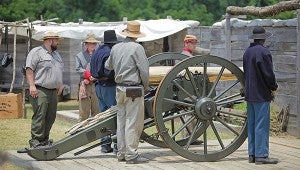VNMP sharing war stories
Published 12:00 am Saturday, June 21, 2014

Living history volunteers cool down Friday after firing a cannon as part of a demonstration at the Vicksburg National Military Park.
Like the figures he must have sung about so frequently in spirituals, Abraham flew to freedom.
And despite all the spirituals about flying the enslaved people of the South sang during their years in bondage, the man only known as Abraham is the only one who ever took to the air and landed in the arms of safety and freedom.
It certainly wasn’t on purpose.
As the Siege of Vicksburg was coming to a close in 1863, one of the hotbeds of fighting was at the 3rd Louisiana Redan, Vicksburg National Military Park ranger Nikki Anderson said.
Named for the 3rd Louisiana Volunteer Infantry, the V-shaped earthwork stood 30 feet high along the sunken Jackson Road. It and the other Confederate earthworks scattered along the battlefield had repelled Union attack after attack.
“The fortifications were like having three times as many soldiers,” Anderson said. “They really did up the manpower for the Confederate soldiers.
In June 1863, members of the 45th Illinois Regiment, many of whom were lead miners before the war, were tunneling under the redan in a plot to explode more than a ton of black powered below the Confederate stronghold.
“These men did things we can only imagine,” Anderson said.
Confederates tasked slaves — Abraham among them — with digging countershafts. After all, the Confederates could hear the Union soldiers tunneling, and leaders from both sides had studied the same book on siege warfare at West Point.
At 3 p.m. on June 25, the 2,200 pounds of powder was ignited. Union forces who rushed into the crater could not escape and were slaughtered.
It’s unclear where Abraham was that day.
Despite the failure of the first explosion and attack, the Union tried again on July 1. All slaves who had been digging countershafts were buried alive, except for Abraham.
“He was blown about 300 yards in the air,” Anderson.
Though badly bruised, Abraham survived his decent from the heavens.
“…[H]e was but little the worse for his aerial voyage,” Theodore R. Davis wrote of Abraham in the Aug. 8, 1863, edition of Harper’s Weekly.
After recovering from his wounds, Abraham became a cook for the Union army.
Abraham’s story is just one of many from the 3rd Louisiana Redan and other historical sites around the park that are being shared this summer at VNMP. For more information about the summer program schedule, call 601-636-0583.






